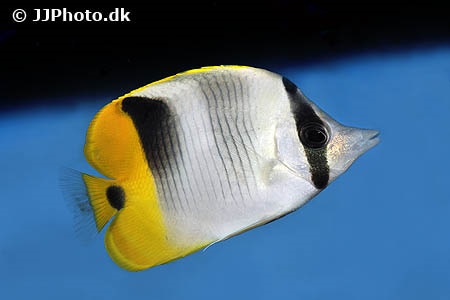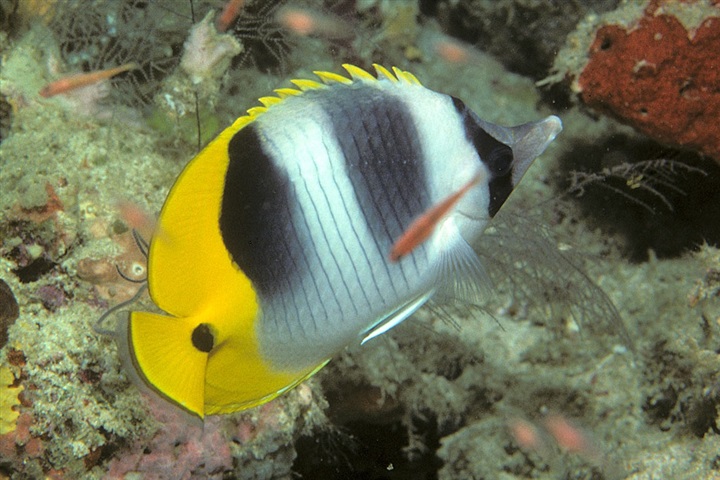Chaetodon ulietensis
| Latin name | Chaetodon ulietensis - Cuvier, 1831 |
|---|---|
| Local name | Pacific double-saddle butterflyfish |
| Family | Chaetodontidae - Chaetodon |
| Origin | East Indian Ocean, West Indian Ocean, Australia, Indonesia, East Pacific, Central/West Pacific |
| Max length | 15 cm (5.9") |
| Minimum volume |
300 l (79 gal) |
|---|---|
| Hardiness |
Hardy |
| Suitable for aquarium |
Suitable with care |
| Reef safe |
Not reef safe |
| Aggressiveness | Peaceful |
| Recommended |
Larger crustaceans (Shrimp, crabs...) Other invertebrates Small crustaceans (Krill, mysis, artemia...) Zooplankton (Cyclops, pods...) |
|---|---|
| Mostly |
Large polyp stone coral (LPS) Soft coral |
This species likes to eat tubeworms.
This species likes eating anemones.
This species sometimes nibbles at clams including Tridacna species.
This species must be fed with an appropriately varied diet.
This species will better acclimatize to the aquarium`s condition if introduced, when young.
Very small individuals can be very delicate.
This fish requires feeding several times a day, especially when newly added.
When the fish can find its natural food in the aquarium it requires less frequent feeding.
This species can function in large numbers down to just one.
This species needs good hiding places, for example, between live rocks.
This species revels in swimming and requires an aquarium with ample space.
This species eats glass anemones (Aiptasia).
But occasionally one finds an individual fish which refuses to eat them.
This species can be very shy when first introduced into a new aquarium.
More aggressive fish can be introduced after this species has acclimatized.
Some species of the Chaetodon genus are grouped together in what is known as a "complex", since they are so very similar.
Regardless of resemblance, it is important to be able to distinguish them, as in some cases they vary greatly in their needs. Sometimes there are just small differences in colour or pattern, but in other instances it is vital to know where the fish originally come from.
The Butterflyfish are known for their attractive patterns and colours. They are closely related to Angelfishs, but can always be distinguished, as they lack the spines on each side of the head of the Angelfish.
A smaller group of these fish will seek out primairily soft corals, like Zoanthus. A larger part of the species will target different types of LPS corals. Butterflyfish are also known to seek out anemones, tubeworms and bristleworms.
Therefore it is important to choose the correct species in relation to the corals wanted, if one desires to keep Butterflyfish in a coral-aquarium.
Bristleworms, tubeworms and other small invertebrates are also a part of the diet for many Butterflyfish.
It can be problematic, with many of these species, to get them eating in the beginning, but many of the species cannot resist live zooplankton or live mussels with crushed shells. Another option is to mimic their natural behaviour by stuffing their food into coral skeletons or stones.
They ignore most other fish and are generally peaceful, therefore multiple Butterflyfish will have no problem living together. One should however be cautious about keeping similar species together unless they are a couple.
As these fish can be difficult to acclimatize and get feeding, it is important to buy healthy fish, to avoid having to deal with more problems. Make sure to check that they do not have parasites or any visible infections.
There are some species that should not be kept in an a aquarium, as they are food specialists and will almost always refuse to eat replacement foods. It can be possible to breed some species, which will eat frozen foods. Otherwise the only way to keep food specialists is by feeding them their natural diet, which consists of live SPS or LPS corals for example.
| Aquarium trade | Yes |
|---|---|
| Distribution | Indo-Pacific: Cocos-Keeling Islands to the Tuamoto Islands, north to Japan. |
| English common names |
Sickle butterflyfish Doublesaddle butterflyfish Pacific doublesaddled coralfish Pacific double-saddle butterflyfish Pacific doublesaddle butterflyfish Pacific double-saddled butterflyfish |
| Danish common names |
Dobbeltsadlet fanefisk |
| French common names |
Papillon à deux selles du Pacifique |
Bob Fenner. Corallivorous Butterflyfishes… For Aquariums? - Wet Web Media - (English)
Scott W. Michael. 2004. Angelfishes and Butterflyfishes (Reef Fishes Series Book 3) TFH Publications / Microcosm Ltd. - (English)
Bob Fenner. Butterflyfishes; Separating the Good Ones and Those You Don't Want - Wet Web Media - (English)
Collection of links to additional information - Wet Web Media - (English)
Tea Yi Kai. 2014. Reef Nuggets 2: Aquatic Lepidopterans for your reef (Revised edition) - Reef Builders - (English)




